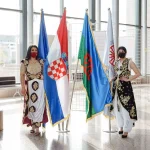The Romani population has lived in the lands that are today part of the Republic of Croatia for over six centuries, which makes them one of the oldest minority groups – says the research by Dr. Danijel Vojak, a historian who, after getting his Ph.D. in history from the Faculty of Humanities and Social Sciences at the University of Zagreb, now works as a researcher for the Ivo Pilar Social Research Institute.
Being a member of The Gypsy Lore Society (USA), the European Academic Network on Romani Studies (EU), and the Croatian National Board for Historical Sciences (HNOPZ), with 45 domestic and 53 international participations in scientific discussions, he has become very well respected in the field of researching the history of Roma people and Croatian Roma history.
The Croatian public may remember an article about his work in the Nacional publication where he explained his research on how the fascist affiliate Independent State of Croatia (Nezavisna Drzava Hrvatska/NDH) killed around 15,000 Roma people, leaving a very dark stain on the pages of Croatian Roma history.
”The document shows how Roma people weren’t poor even though they lived on an economic margin. They legally acquired properties until their belongings were taken by the state,” stated Vojak for Nacional in 2019.
As the Ivo Pilar Social Research Institute recently informed people, last week, from September 8-10, Vojak participated in an annual conference by the Gypsy Lore Society that took place in Karlova University in Prague.
The topic of Vojak’s latest scientific lecture was titled ”Marginals on the Sidelines of the Education System or on Education About the Roma Genocide in Croatia, 1945-2020,” which explores how the genocide over the Roma people in Croatia during World War Two has sadly escaped the memory of the past.
”Even today, very little is known about the extent of this genocide committed against the Roma during the reign of the Independent State of Croatia (ISC/NDH). The marginalisation of scholarly interest in researching the genocide committed against the Roma people was one of the characteristics of the communist ideological model of the authorities in socialist Croatia (Yugoslavia), which prohibited the highlighting of ethnic identities among victim groups, and instead incorporated them into the common discourse of ”victims of fascist terror”.
With such ideological control, the memories of the Romani war victims were joined by those of other victims of the Ustasha authorities and its fascist and Nazi allies, which made it impossible to hold separate commemorations or to erect monuments for the Romani victims,” said Vojak during his presentation, as explained by the Ivo Pilar Social Research website.
As Vojak warns, the effect of Yugoslavian policies still has consequences today as scholars take on Roma suffering during WW2, and what is uncovered remains insufficient and unsystematic.
Founded in the UK in 1888, moving its headquarters across the Atlantic to the USA in 1989, the Gypsy Lore Society takes an interest in Roma people but also in other communities and cultures that are commonly known as gypsies in the English language.
”The research field of the Gypsy Lore Society has traditionally included many different communities which, regardless of their origins and self-appellations in various languages, have been referred to in English as gypsies. These communities include the descendants of migrants from the Indian subcontinent, which have been considered as falling into three large subdivisions, Dom, Lom, and Rom. The field has also included communities of other origins that practice, or in the past have practiced, a specific type of service nomadism. The breadth of society’s interests is reflected in the articles published in its journal and papers presented at its conferences,” explains the Gypsy Lore Society.
The promotion of studies on said communities (their history and culture in a worldwide sense), the dissemination of accurate information in the hope of increasing the general understanding of their diversity, as well as establishing closer contacts with the researchers of the same interest; are all goals the society aims to promote.
”The society sponsors programmes and conferences and publishes the twice-yearly Romani Studies (continuing Journal of the Gypsy Lore Society), a quarterly newsletter and other occasional publications,” the Gypsy Lore Society summarised when stating its activities.
Along with Croatian Roma history throughout WW2, as TCN previously wrote, there is also a lack of historical memory on Roma people in the Homeland War in the 90’s.
Things moved in a positive direction in 2019 when Borna Marinić presented his book, “We defended Croatia Too: Roma People in the Homeland War“.
But, as Vojak warns when talking about the unsystematic and insufficient take on the history of Roma people, Croatian scientists have a lot more digging to do in order to properly tell the story about the oldest minority in Croatia.
Learn more about Croatian politics and history from the 1990s on our TC page.
For more about science in Croatia, follow TCN’s dedicated page.












